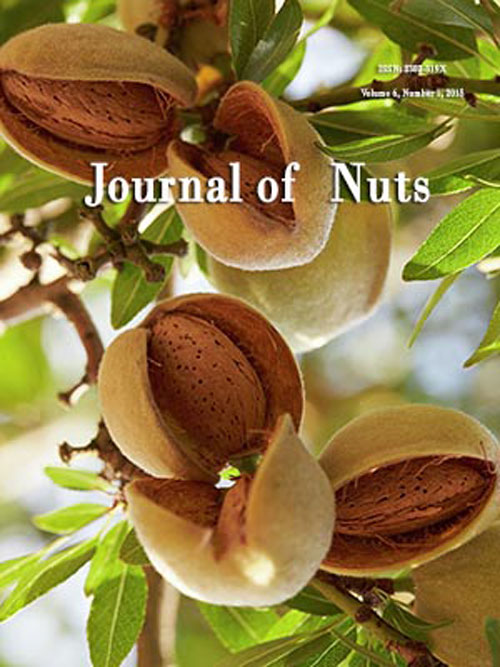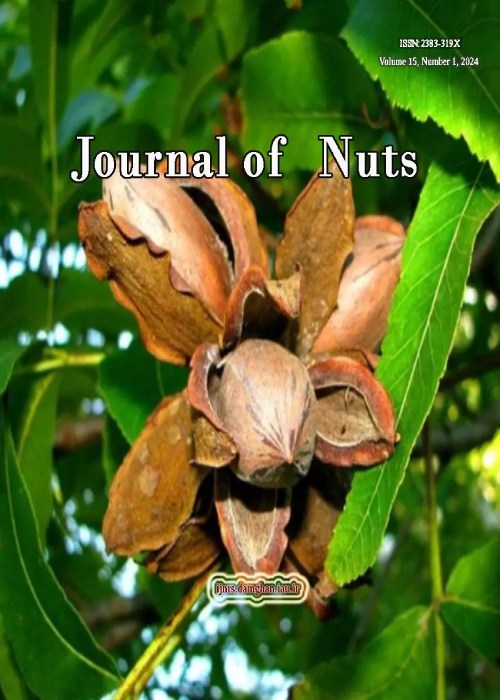فهرست مطالب

Journal of Nuts
Volume:7 Issue: 1, Winter-Spring 2016
- تاریخ انتشار: 1395/03/31
- تعداد عناوین: 8
-
-
Pages 1-8Late spring frost is one of the most important factors causing loss of production of the Persian walnut (Juglans regia L.). Therefore, the selection of spring frost tolerant genotypes has been among the most important priorities in the breeding programs during the recent years in Horticultural Science Research Institute, Karaj-Iran. After the spring frost in 2010, five superior genotypes (B10, H1/1, H1/7, H2/1, and H2/12) were selected among 250 walnut genotypes of Kamalshar walnut collection in Karaj. At the second stage, vegetative and reproductive characteristics (Leafing and flowering date, yield, nut and kernel) of the selected genotypes were evaluated and compared with Chandler, Hartley, Pedro, Ronde de Montignac and Franquette in 2010 and 2011. Among the genotypes, H2/12 with 534 and 312g/m2 of scaffold cross area of nut and kernel yield showed the maximum production. The H2/1 with 3.37 nut/ cm2 of trunk cross sectional area and H2/12 with 48.1 nut/m2 of scaffold cross area showed the highest crop density. Based on this evaluation, the five promised walnut genotypes showed very good performance in comparison with the commercial walnut cultivars.Keywords: Juglans regia L, Selection, Spring frost, Superior genotype, Walnut
-
Pages 9-20The nutritional problems in almond orchards have increased because of alkaline soils and insufficient nutrition. This study was done to evaluate the effect of nano-chelate super plus ZFM (Zinc, Iron and Manganese) spraying on quantitative and qualitative characteristics of almond commercial cultivars. This work was carried out in factorial experiment base on randomized complete block design with three replications. A factor involved different almond cultivars (Shokufeh, Monagha and Sahand) and B factor involved the time of nano-chelate super plus ZFM (2g/l) application with four time treatments T1: bud swelling phase, T2: two weeks after bloom end and T3: Application in two stages, bud swelling phase (T1) and two weeks after bloom (T2) and T4: control (spraying with water). Different traits, such as yield per shoot, initial and final fruit set; fruit abscission, length, width and fresh and dry weight of nut and concentration of microelements in leaves were measured. The results showed that the concentration of micro elements (Zn, Fe, Cu and Mn) in leaves increased significantly in all treatments especially when spraying in two stages compared to control. Also, the interaction of time of spraying and cultivar was significant in all measured traits except fruit abscission. The highest percentages of initial and final fruit set and yield per shoot were observed in Shokufeh cultivar and fertilizer spraying in two stages (T1 and T2), and the lowest percentage of initial and final fruit set was observed in control in all tested cultivars. The simple effect of spraying time on fruit abscission was significant in 1% level and also percentage of fruit abscission decreased about 25% compared to control in application in two times (T1 and T2).Keywords: Bloom end phase, Nano, chelate, Nutritional problems, Spraying, Swelled bud phase
-
Pages 21-33In this study, changes in soil moisture and salinity contents in drip irrigation combined with white and black plastic mulches compared to no mulch (control) was evaluated. The experiment was carried out in two commercial pistachio orchards (Ohadi cultivar) with irrigation frequencies of 8 to 12 days with a total water consumption 4100 and 6170 m3ha−1. The study was conducted in a complete randomized block design with three replicates from 2014-2015. Results showed that plastic mulches significantly affected the studied parameters, such as dry yield and water use productivity (WUP). The WUP in plastic mulch treatments increased from 36% to 100% compared to the control. On the other hand, soil moisture content in plastic mulches were up to 12% higher than control in irrigation intervals in both orchards. Moisture content equations between two consecutive irrigations obtained in depth of the maximum root development (25 to 75cm). Proper irrigation frequency in pistachio trees with sandy loam to loamy sand soil was determined based on the derived equations and PWP and RAW in soil experimental plots. The frequency was six to eight days in the case of no mulch, and in the use of plastic mulch, it was 11 to 15 days. The results showed that the use of plastic mulch decreased the soil surface salinity from 30.8% to 51.8% compared to the control. The amount of water consumption, irrigation frequency, soil texture and sampling points affected the soil surface salinity. The average salinity of 0-120cm soil depth was reduced from 20.4% to 27.7% compared to the no mulch treatment. The mulch color did not have a significant effect on any of the parameters.Keywords: Irrigation frequency, Pistachio, Polyethylene mulch, PWP, RAW, WUP
-
Pages 35-44Studies of physiological diversity and its effect on the expression of traits in plants are used in breeding programs as a selective tool with the aim of selecting special attributes for creating a new product. In this study, the correlation coefficients among 17 horticultural traits of 34 genotypes from 11 different places of Semnan province were examined. A significant positive correlation was observed between fruit weight and kernel weight, susceptibility to blight and leaf abscission, leafing date and female flower emergence and between kernel percentage, kernel weight and kernel plumpness. Furthermore, a significant negative correlation existed between harvest time and tree vigor, fruit shape and fruit weight and kernel percentage with shell thickness. The most important characteristics that had a direct impact on kernel percentage were shell thickness and kernel plumpness. The attributes that were effective on fruit ripening were tree form, catkin emergence time and shell thickness. However, the residual effects suggested that there might be other important determinant traits for harvest date, which were not considered in this study.Keywords: Correlation, Kernel percentage, Path analysis, Walnut
-
Pages 45-50The aim of this study was to determine the effects of different plant growth regulators, NAA (0 mg/l, 50 mg/l and 100 mg/l) and GA3 (0 mg/l, 50 mg/l and 100 mg/l), with various boron concentrations (0 mg/l, 50 mg/l and 100 mg/l) on pollen germination of Şaba, Rabie and Padre almond cultivars in 10% sucrose and 1% agar medium at 24°C in dark conditions. The results showed that different treatments had significant effects on the percent of germination. The highest pollen germination (average 90.37%) for three almond cultivars was recorded in 100 mg/l boric acid, 10% sucrose and 1% agar medium. The lowest germination percentage (average 3.59%) was found in 50 mg/l NAA, sucrose 10 % and agar 1 % medium for all cultivars. Pollen germination rates significantly decreased with increasing growth regulators in almond cultivars. The pollen germination was greatly inhibited in media with GA3 and NAA or compound from these materials without boric acid. For example, mean pollen germination rates was %15.51 in 100 mg/l GA3 10% sucrose 1% agar, while this value was 82.89% from the 100 mg/l GA3흍 mg/l Br 10% sucrose 1% agar.Keywords: Almond, Growth regulators, Pollen germination
-
Pages 51-58In order to study the contamination of Aspergillus flavus and aflatoxin production in pistachio cultivars in the Semnan province, eight cultivars of pistachio were collected from major pistachio growing areas. Using the serial dilution method, ground pistachio kernels were inoculated on plates containing AFPA medium and incubated at 28° C. This experiment was performed using three replications in a completely randomized design. After three to seven days, the number of A. flavus colonies were identified and enumerated. Also, aflatoxin B1, B2, G1 and G2 contents of the samples were analyzed by HPLC method. On the other hand, the effect of two chemical fungicidesas a control method on the growth of Aspergillus flavus and aflatoxin production in pre-harvest pistachio cultivars was assessed under in vivo conditions. For this purpose, an orchard that was under cultivation by the most contaminated cultivar was selected, and a completely randomized design was carried out in the field. Two fungicides (tebuconazole 25% and mancozeb 80%) were applied at an application rate of 1 and 2 L or Kg ha-1, respectively. Aflatoxin B1 and B2 contents of the samples were analyzed using the HPLC method. The obtained results showed that there was a significant difference in A. flavus colonies number in different pistachio cultivars. Among these cultivars, Owhadi had the highest amount of contamination, and Akbari had the lowest contamination. The results showed that the contents of aflatoxin B1 and B2 were observed in Owhadi cultivar. , Tebuconazole 25% and mancozeb 80% reduced A. flavus growth compared to the control. However, this reduction was not significant. The obtained results of aflatoxin analysis showed that these two fungicides reduced the amount of aflatoxins B1 and B2 in pistachio cultivar, though there was not a significant reduction.It was concluded that the use of chemical fungicides were ineffective in preventing A. flavus growth and aflatoxin production in pistachio cultivars under in vivo conditions.Keywords: Aflatoxin, Aspergillus flavus, Fungicides, HPLC, Pistachio, Semnan province
-
Pages 59-66Almond [Prunus dulcis (Mill.) D.A. Webb] is one of the most important cultivated fruit trees in Iran. Late frost in spring is a key limiting factor for almond productivity given that almond trees flower early in the spring in comparison with other temperate fruit trees. To decrease frost injury in Mamaei cultivar, this study was carried out in factorial randomized complete block design (CRBD) with four replications. Almond trees were sprayed with 5%, 10% and 15% concentrations of Volck® mineral oil mixed with a constant 3 g.l-1 concentration of Copper Oxychloride at two separate times, before swelling bud stage and at the swelling bud stage. The control almond trees were sprayed with pure water. The parameters such as phenological development stages of flower bud, amount of frost injury, bud abortion, fruit set and yield were measured. The results indicated that the trees treated with Copper Oxychloride and Volck® mineral oil did not show significant effects on blooming time but had a significant effect on other parameters. The result of the mean comparison indicated that the highest percentage of bud abortion (1.84%) occurred by using 15% oil concentration and the lowest bud abortion (0.49%) occurred in the control trees. The highest yield (7.9 kg/tree) was achieved by the use of 5% Volck® mineral oil plus 3 g.l-1 Copper Oxychloride during the swelling bud stage.Keywords: Bud abortion, Development stages, Frost injury, Fruit set phenological
-
Pages 67-74Excessive salt accumulation in soil is a major ecological and agronomical problem, especially in arid and semiarid areas. Excessive soil salinity affects the establishment, development and growth of plants, resulting in major losses of production. A pot experiment was set up to examine the effects of arbuscular mycorrhizal fungus (Glomus etunicatum and Glomus versiforme) and salinity on the growth, pigment concentration, biomass and nutrient acquisition of pistachio (Pistacia vera L.) seedlings. Two-month-old pistachio seedlings colonized by G. etunicatum and G. versiforme were irrigated with 0 and 150 mM NaCl solution for 45 days to induce salt stress. The results showed that salt stress significantly reduced mycorrhizal colonization in pistachio seedlings, and G. versiforme was found to be more colonized than G. etunicatum. Mycorrhizal inoculation, especially G. versiforme, had higher plant growth, biomass and pigment content than non-mycorrhizal under control and salt stress treatments. Shoot Na concentrations were lower in mycorrhizal than in non-mycorrhizal seedlings under given salinity conditions. Total P, K, N, Ca macronutrients and micronutrients decreased with soil salinity in both mycorrhizal and non-mycorrhizal seedlings. These nutrients were higher in AM, especially G. versiforme, than in NM seedlings in control and salt stress treatment. The results suggested that mycorrhizal, especially G. versiforme, pistachio plants exhibited greater efficiency in alleviating salt stress, which resulted in better growth.Keywords: Glomus etunicatum, Glomus versiforme, Growth, Mineral nutrition, Pistacia vera, Salinity


